by Daniel J. Leonard | Jul 20, 2018
Too often, would be gardeners travel to exotic locales, become intoxicated with the beautiful floral display of Plumeria, Jatropha, Bird of Paradise and Bougainvillea, and come home with visions of homemade leis picked from the garden dancing in their heads. As anyone who has attempted to grow any of the aforementioned plants in the Panhandle will tell you though, fulfilling those visions in the landscape are easier said than done! However, not all is lost for the gardener wanting to bring the tropics home. A tropical feel in the landscape can be achieved, you just have to look beyond the aforementioned flowering plants that will have long since succumbed to winter frost by the time they mature and begin flowering and instead to tropical foliage plants that can be enjoyed for a season and easily (cheaply too!) replaced the following spring. Of all the tropical foliage options available for Panhandle landscapes, my favorite is the Ti Plant, sometimes called Hawaiian Ti.
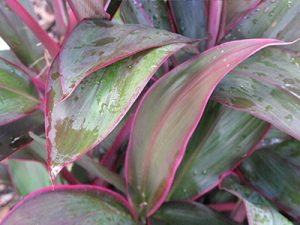
Ti Plant foliage
Even if you have never heard of Ti, you have probably seen it. The strap like, 12-18” long, purple and pink striped leaves are hard to miss and add an unmistakable tropical flair in the landscape! Ti Plants grow generally in single, unbranched stalks, though most commercial growers combine several plants into a single pot to give a bushy, multi trunked appearance that looks more appealing on a retail nursery bench. These plants will easily reach 4-6’ in height in a single warm season, providing a powerful punch of pink/purple all summer long. In addition to its considerable attractiveness, Ti boasts a cosmopolitan constitution, as it will grow in sun or shade, outside or inside. Of course, some cultural do’s apply to Ti broadly, regardless of where it is grown, as well as a few don’ts.
In general, Ti will be more colorful in brighter light. Though it grows well in shade, its leaves tend to lose their luster and fade to a dull purple in full shade. Similarly, though it will survive in full, all day sun, Ti’s foliage tends to bleach a bit in these conditions and can turn a whitish gray. It is best to shoot for somewhere in the middle for the most vivid foliage color. If growing indoors, give Ti as much light as you can. If growing outdoors, full sun through midafternoon is appropriate, as is bright shade throughout the day. Be sure to give Ti plants consistent moisture, as they will readily wilt down under prolonged drought conditions. As with watering, Ti prefers a consistently fertile soil and will appreciate a topdressing of a complete, slow release fertilizer (made by Osmocote, Harrell’s and others) at planting, with a follow up application 60-90 days later (possibly more frequently depending on temperature and frequency of watering).
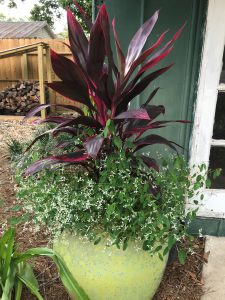
Ti plant in a mixed container – Photo Courtesy Daniel Leonard
Though Ti performs well planted in the ground in Northwest Florida as an annual specimen to brighten a border (think of it like a supersized Coleus), it really gets to shine in large, mixed containers. Ti’s upright growth habit and traffic stopping color make it the perfect thriller in the widely used “thriller, filler, spiller” container design. Because Ti can grow quite large relative to other common container plants, a large 20-45 gallon container is necessary to facilitate optimum root growth and plant development. If a smaller container is chosen, water management will become an issue as the Ti plant’s root mass will quickly crowd the container. I prefer glazed ceramic or concrete containers as these are often painted in bright colors that complement Ti’s foliage, do not allow as much air exchange as terra cotta planters (soil in terra cotta containers dry very quickly in hot, dry weather), and are heavy enough that tall Ti plants won’t cause them to blow over in windy conditions. Mix smaller, mounding filler plants and trailing spiller plants under and around Ti in containers. For a striking contrast in color, choose companion plants in white, yellow, orange or chartreuse (remember, plants don’t have to flower to be colorful, vivid foliage plants like coleus or caladium work too!).
Regardless of how you use Ti Plant, you’ll find it to be one of the most high value color plants in the landscape. Plant one today and happy gardening!
by Molly Jameson | Jun 21, 2018
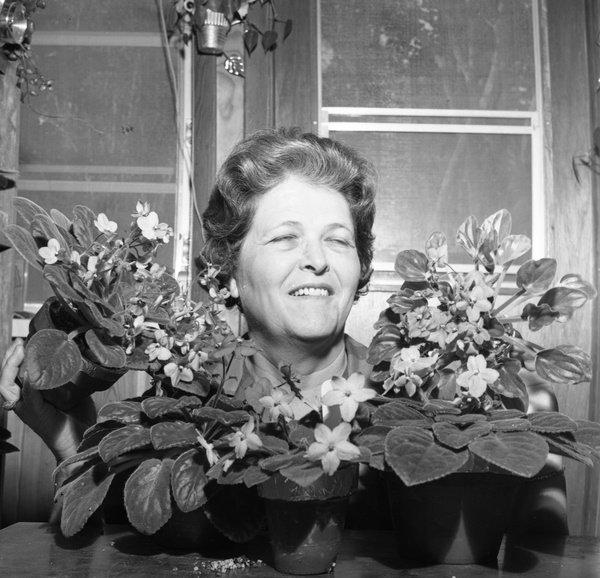
Mrs. Henry C. Mills in 1966 with her African violets at the North Florida Fair
flower show. Photo by Dan Stainer/State Archives of Florida.
Growing up, as soon as I entered the fair gates, I always headed straight for the rides. If I was lucky, I was able to get an unlimited pass strapped around my wrist and didn’t need to worry about rationing any tickets. Although I usually didn’t remember the names of particular rides – they were clear in my imagination. The spaceship, the circular mini roller coaster, the alien arms… and of course, the Ferris wheel. It wasn’t until I was about a dozen rides in – and starting to feel a little queasy – that the fun houses and win-a-goldfish-by-throwing-a-ring or shoot-a-basketball-for-a-giant-stuffed-tiger games drew my attention. After that, I was ready for funnel cake. Maybe even a corn dog and an assortment of fried cheese, pickles, and the like. Inevitably, I would eat too much and be out of commission for any more rides I was hoping to squeeze in – or squeeze into! This is when I might finally make my rounds through one or two of the giant warehouse-looking buildings that lined the way to the exits, where I knew there was at least a llama or a goat to be fed at the petting zoo.
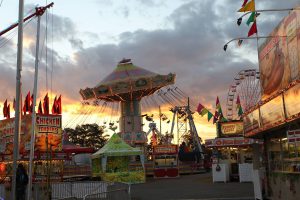
Instead of simply attending the North Florida Fair this year, submit your garden’s best for competition. Photo by North Florida Fair.
But when I started volunteering at the Leon County Animal Shelter as part of the 4-H Pet Partners at age 12, I was introduced to these buildings in a whole new light. We were assigned the task of creating papier-mâché cats and dogs to display at the fair to help build awareness of pet overpopulation. I remember my dog well – he was beagle-like, with long droopy paper ears and stiff pointy legs that I struggled to keep balanced. The day we went to set up our display, my adrenaline soared, as I knew our creations were to be judged and ribbons to be bestowed. Ever since, I no longer view the fair buildings as a last stop – rather, I relish my stroll through each of them, as they contain so many handmade treasures, many of which are adorned with blue rosettes of triumph.
The tradition of displaying and competing for the best quality handiworks at the fair goes all the way back to the Middle Ages and Renaissance, where merchants sold and traded agricultural goods that had been grown over the summer and freshly harvested in the fall. Naturally, competitions arose during these times, as they strove for the finest products.
Today, fairs reflect the personality of an area, and nearly universally include judges who inspect home grown fruits and vegetables, flowers, preserved foods, and baked goods entered into competition by the community. The North Florida Fair awards about $80,000 in cash prizes to citizens who create and grow various items. Anyone living within the 24 counties that comprise North Florida – from the Suwannee, west to the Alabama line – is eligible to enter as many of the exhibit categories as they would like.
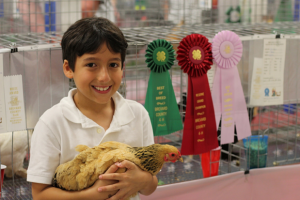
A youth showcasing his prize winning chicken at the North Florida Fair. Photo by Aly Donovan.
The exhibits are arranged into various departments, such as Home Agriculture, Capital City Garden Club Flower Show, Poultry, Baked Goods, and Fine Arts and Crafts. Within each department, there are various classes that are split into certain age divisions (i.e., youth only) or experience levels (i.e., amateur vs. professional). Under the Home Agriculture department there are 42 classes, including 13 classes covering fresh vegetables. The Capital City Garden Club Flower Show department has 13 classes, including annuals, perennials, hanging baskets, fruiting shrubs, trees, and vines, succulents, and much more. If you would like to submit something you’ve grown, now is the time to begin planning, as this year’s fair is set for November 8-18.
All of the details for each department and class can be found on the North Florida Fair website (http://northfloridafair.com/), under the Exhibitors tab. Pay close attention to the application and submittal deadlines for each specific category, as most items are due for judging the week prior to the fair opening.
So, let nostalgia win you over as you prepare your home-grown vegetables and flowers for submittal to the North Florida Fair. You might just earn a blue ribbon to be displayed for all fair attendees to admire, either as they walk off a full stomach in preparation for more rides, on their way to the exits, or just as they get started creating their own fond fair memories.
by Daniel J. Leonard | Jun 21, 2018
It’s that time of year. School is out, hurricane season is in, and the mercury is up! Gardens wilt by midday and gardeners retreat into the air conditioning long before then. Unless you have your toes in the water on one of Northwest Florida’s beautiful beaches, it can be a miserable time to be a Floridian, for plants and people! However, despite the relentless heat and blistering sunshine, low-maintenance, eye-catching color can still be had in the landscape. When the calendar flips to June, I turn to my two favorite Florida-Friendly annuals to do the heavy lifting in my landscape: ‘Diamond Frost’ Euphorbia, and the ‘Cora’ Vinca series.
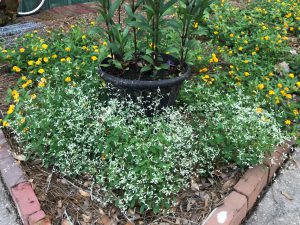
‘Diamond Frost’ Euphorbia – Photo Courtesy Daniel Leonard
A relative newcomer to landscapes, the award winning ‘Diamond Frost’ Euphorbia is an amazing introduction from Proven Winners. The ultimate in tough, ‘Diamond Frost’ does great both as a mounding accent in a container or as a standalone bedding plant in the landscape. Though its individual, teardrop-shaped, white flowers are tiny, the hundreds of them that open each day really pack a floral punch in the landscape! One caveat: if planting in the landscape, I find ‘Diamond Frost’ to be most effective massed in groups of three or more. Due to the daintiness of the flowers, a single plant can get lost among other garden inhabitants. However, when done right, ‘Diamond Frost’ is a proven winner in any landscape!
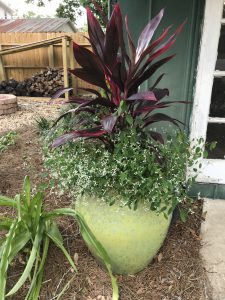
Mixed container featuring ‘Diamond Frost’ Euphorbia – Photo Courtesy Daniel Leonard
Next, the ‘Cora’ series of Vinca (Catharanthus roseus), also introduced by Proven Winners, is an improvement on an old favorite. Note: This species is also, on occasion, called Periwinkle. However, do not confuse it with the spreading, purple-flowered, perennial groundcover of the same common name! Gardeners in the South have been growing Vincas for years. This species is unbelievably tolerant of harsh conditions, sometimes even seen growing in sidewalk cracks! However, the unimproved species had an Achilles heel: susceptibility to Phytophthora, a devastating fungal rot disease. ‘Cora’ overcomes this issue and is as close to a perfect bedding annual as you’re likely to find. The ‘Cora’ series is composed of cultivars with pinwheel-shaped white, pink and lavender flowers, a color for everyone! The kind (and clever) marketing folks at Proven Winners have even made ‘Cora’ easy to spot on retail nursery benches; just look for the plants in the hot pink containers!
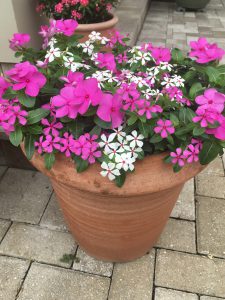
‘Cora’ Vinca
Photo: Andrea Schnapp
Both of the above-described plants are extremely undemanding of gardeners. Once established, little is required in the way of irrigation and fertilization. To ensure success, water daily for the first week after planting, back off to a couple of times per week for the next two weeks or so and then watch ‘Diamond Frost’ and ‘Cora’ thrive with only rainfall for the rest of the summer! Keep in mind, during periods of excessive drought, supplemental watering may be required to keep any plant, even drought tolerant ones, looking their best! To meet the minimal nutrition demands of these plants, I incorporate a quality, slow-release fertilizer (for example, Osmocote, Harrell’s Polyon, or any other similar product) at planting. These products last two or three months in our rainy, hot, humid climate and generally need a second application accordingly for full-season performance. ‘Diamond Frost’ Euphorbia and ‘Cora’ Vinca also require full, blazing sun for maximum floral performance. Don’t be shy about siting them in harsh, sunny places, even a few hours of shade tend to make leggier plants that flower less!
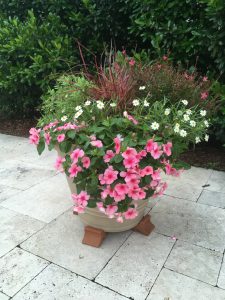
Mixed container with ‘Cora’ Vinca accent
Photo: Andrea Schnapp
When you need low-maintenance, season long color that can beat the heat, look for ‘Diamond Frost’ Euphorbia and the ‘Cora’ series of Vinca at your local nursery! Stay cool out there folks and happy gardening!
by Beth Bolles | Jun 7, 2018
There is one tough annual plant that thrives in the summer garden and provides bright color in our sun and heat. Portulaca or moss rose (Portulaca grandiflora) is strong performer, even growing well when reseeding in sidewalk cracks and stone walkways. Of course it will be most attractive when used in containers or well drained landscape beds in bright sunshine.
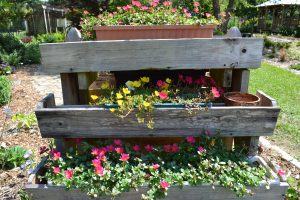
Containers of portulaca brighten an entrance to the herb garden at Escambia County Extension Demonstration Gardens. Photo by Beth Bolles, UF IFAS Extension Escambia County
The thicker, flattened leaves of portulaca make is adaptable to drier conditions. The plants are only about 6 inches tall but branches will spread out a foot or so from the center. The attractive flowers extend just above attractive green foliage in colors of yellow, pinks, and oranges. Portulaca is extremely versatile, making it a good filler in a container or at the edges of flower beds along hardscape areas.
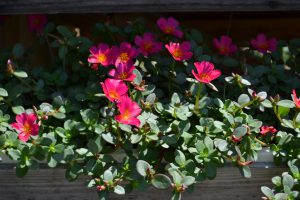
Bright flowers of portulaca reach for the sun. Photo by Beth Bolles, UF IFAS Extension Escambia County
Portulaca will not perform the best when soils remain too moist or days stay overcast for extended periods. Flowering will also be reduced if water is totally lacking. Maintain a balance by providing a quality soil that drains well.
Although many gardeners prefer perennials to annuals, portulaca can provide a big impact in the summer garden for a small investment.

by Larry Williams | Dec 1, 2017

Tulips at the U.S. Botanical Garden in Washington, D.C. Image Credit: IFAS Gardening Solutions
Q. I’ve seen the beautiful tulips of Amsterdam and would like to grow some here in North Florida. So I ordered some tulip bulbs. Can I plant these in North Florida?
A. Tulips are treated as annuals in Florida. We have two problems with tulips this far south. First, they do not receive enough cold weather to meet their requirements to bloom. Secondly, it gets hot quick enough in the spring to cause the foliage to die prematurely, which does not allow the tulip plants enough time to store sugars in the bulb to resume growth the following year. As a result, the bulbs become smaller and weak and flower poorly if at all the following year. At best you may get one to three years’ worth of blooms out of a tulip in our area no matter what you do. Most tulips will only bloom once in our area and then they are spent. Florida doesn’t provide the right kind of weather for tulips. We may have cold weather for a few nights. Then it warms again. This goes on all winter. Tulips need consistently cold weather in order to initiate flower buds.
You can provide an “artificial cold winter” by placing the bulbs in a refrigerator for about 8 weeks prior to planting. This requires purchasing the bulbs ahead of time in order to provide this chilling treatment and still have time to plant during late fall to mid-winter (late November to mid-January). Some nurseries sell pre-chilled bulbs, most don’t. The above treatment will meet their requirements for flowering but does nothing to offset the fact that it gets warm too quickly in the spring for tulips.
The few people that grow tulips in Florida either buy pre-chilled bulbs or place them in the refrigerator, plant them, enjoy their blooms the following spring and then throw them away. They treat them like annuals.

by Ray Bodrey | Nov 20, 2017
Do you want to add a little something different to your landscape? How about something edible, as well as a focal point in your garden? Backyard sugarcane may be just what you are looking for.
Sugarcane, genus Saccharum, is a tropical perennial grass that thrives in humid environments across the southern United States. Based on physical and chemical characteristics, there are 3 types of sugarcane. Chewing canes (Yellow Gal, Georgia Red varieties) are soft, with fibers that stick together when chewed. Many of these canes are also used for syrup production. Crystal canes, used mainly for commercial purposes, contain a high percentage of sucrose. This is the molecule that crystalizes into granular sugar. Syrup canes (Louisiana Ribbon, Green German varieties) contain less sucrose, therefore less crystallization, making for a more fluid product. Some varieties of each type are interchangeable. For example, some crystal canes are satisfactory for chewing cane.

Figure 1: Sugarcane Harvest. Credit: UF/IFAS Communications.
How does one plant sugarcane? Sugarcane is propagated by “seed cane”. Mature cane stalks have nodes, about every 6 inches, that produce buds. The stalks are cut into 2-3 foot segments and then planted. After the following harvest, the sugarcane sprouts from the buds of the old stalks, through a process known as “ratooning”. Be patient when growing sugarcane. It takes approximately 12-14 months for the original planting (seed cane) to produce mature cane, while another year to produce cane from the ratoon.
Seed cane should be planted from mid-August through November. Growth will occur in the spring. Sugarcane can be planted, 4 -10 feet apart, as a single row or multiple rows. A 3-7-inch furrow depth is optimum. Common practice regarding fertilizer is to apply 1 pound of 8-8-8 fertilizer per 10 feet of furrow. Plan ahead, as this crop makes a great windbreak for your vegetable garden.
Avoid planting sugarcane in areas of high traffic. The leaves of the cane are very sharp and some sugarcane varieties can fall and obstruct areas. Well drained soils in a sunny area is the perfect environment. Times of stress, such as lower temperatures for long periods of time, poor soil fertility and pH extremes (best range 5.5-6.5) will cause lower yields. Heavy watering with poor drainage conditions of newly planted seed cane can also disrupt bud germination.
Overtime, many varieties will succumb to disease and other environmental factors. To manage sugarcane against weeds, hand weeding and mulching are the best options. Soil inhabiting worms and grubs, stalk borers, termites and aphids are the biggest threats regarding insect pests. Sugarcane is rapidly growing plant and can tolerate most insect infestations and be productive.
Sugarcane is unique as many of the heirloom varieties are still available. So, where does one find seed cane? The classified ads section of the “Market Bulletin” published by the Florida Department of Agriculture and Consumer Services is a good start:
The Panhandle provides a favorable growing environment for this delightful backyard gardening focal point plant. Contact your local county extension office for more information.
Information for this article is from the UF/IFAS EDIS publication: “Backyard Sugarcane” by L. Baucum, R.W. Rice, and L. Muralles.
UF/IFAS Extension is an Equal Opportunity Institution.













